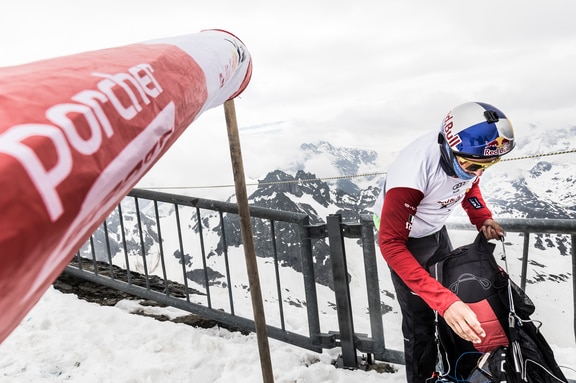Red Bull X-Alps 2019: DAY 7
Details
Red Bull X-Alps 2019: Race Report – day 6
https://www.paragliding.eu/red-bull-x-alps-2019-race-report-day-6/
SPANNENDE ZWEIKÄMPFE BEI RED BULL X-ALPS 2019Die kolumbianischen und koreanischen Teams geben alles, um der Elimination zu entgehen.
Red Bull X-Alps 2019 Athlet fliegt in Grindelwald, Schweiz © zooom.at / Felix Wölk Es ist der siebte Wettkampftag bei Red Bull X-Alps 2019. Und es sind nicht nur die Führenden, die alles geben müssen, um weiter zu kommen.
Eine Regel des Rennes besagt, dass alle 48 Stunden der oder die letztplatzierte Athletin aus dem Rennen genommen wird. Bis jetzt hat der sogenannte “Sensenmann” zwei Athleten erwischt und morgen ist der dritte fällig. Dafür in Frage kommen entweder Koreas Chikyong Ha (KOR) oder der Kolumbianer Alex Villa (COL)
Beide nehmen gänzlich unterschiedliche Routen Richtung Turnpoint 5, Lermoos. Eigentlich hat Villa eine geringere Distanz bis dorthin, aber am Ende zählt nur, wer den Turnpoint als Erstes erreicht. Die Chancen des Koreaners sehen dafür etwas besser aus. Und um das auch tatsächlich zu schaffen, zieht Ha alle Register und nimmt auch seinen Night Pass heute in Anspruch. Er leidet seit Tagen an schmerzhaften Blasen auf den Füßen. „Er darf den Night Pass nur einsetzen, wenn unser Doktor sein Ok dafür gibt,“ sagt Renndirektor Christoph Weber.
Ebenfalls heute Nacht unterwegs sein wird, die einzig verbliebene Athletin im Rennen Kinga Masztalerz (NZL2). Sie sagte, dass das Rennen bisher alle ihre Erwartungen übertroffen hat. „Jeder Tag ist einzigartig.” Den Alpenhauptkamm fliegend zu überqueren war der absolute Höhepunkt. “Wir sind auf 3.300 Meter geflogen. Einfach nur großartig!”.
|
|
|
|
|
Maxime Pinot (FRA4) ist bereit um die Red Bull X-Alps 2019 Krone Christian Maurer (SUI1) wird es Pinot nicht leicht machen
zu kämpfen © zooom.at / Vitek Ludvik © zooom.at / Honza Zak Go with the flowWhen you’re in the Red Bull X-Alps, it’s important to stay in the ‘zone’When it comes to adventure races like the Red Bull X-Alps, it’s important to be in the ‘zone’. But what does this mean – and what role does psychology play when you’re battling challenging conditions, the weather, your rivals and yourself. The concept of ‘flow’ was developed by Mihály Csíkszentmihályi and describes the mental state in which you are fully focused on what you are doing. In this mindset, you are positive, immersed in the task and performing at your best. Put simply, you’re performing at your peak. A simple way of understanding it is via a chart, with your skill level on the horizontal axis and the level of challenge on the vertical. If your skill level is high and you only attempt basic challenges, you will be in the bottom right of the chart – and more than likely bored. On the other hand, try too challenging a task when your skill level is low and you will find yourself in the top left of the diagram – stressed, frightened and, quite possibly, in serious trouble. The key is to keep yourself in the “flow channel” between the two, matching the level of your challenges to your ability. Red Bull X-Alps athletes have extraordinary skills and so can set themselves remarkably difficult challenges – just consider some of the distances run or the conditions some of the athletes have been flying in. Still, they will also be highly attuned to where their limits are. And if they consistently exceed them, they will quickly become highly stressed, exhausted and burnt out. Light, lighter, lightestThe paragliders athletes use are about to get even lighter The Red Bull X-Alps can safely claim to have inspired a whole new direction for the sport of paragliding. With its emphasis on hiking and flying, the race has focused the sport’s attention on how to make the paraglider wings lighter – and then lighter still. A typical recreational paraglider weighs about 5-6kg – but the specialist gliders in the Red Bull X-Alps weigh almost half that, at about 3kg. How has that happened? One important factor is the material that the paraglider is made of. The company behind it is called Porcher, and they make most of the fabric used in all paragliders today. The material is called Skytex 27 – the 27 being shorthand for 27 grams per square metre. That’s how much the material weighs. A typical glider is about 26 square metres – about 700g of cloth. Consider that a paraglider has a top and a bottom surface, and an internal structure, and you can see that about 2kg of cloth is used in each lightweight wing. Amazingly, this lightweight flying machine is about to get even lighter. At the start of the Red Bull X-Alps Porcher announced they will release even a new material next year – Skytex 21. And yes, you guessed it, it will weigh 21 grams per square metre. A near-25% weight-saving over Skytex 27. The result will be even lighter gliders, which will allow athletes to hike for longer and carry their gliders more easily. A true technological revolution in the sport. |
















